Virtual Reality in The Classroom
Tiffany Imparato
Keeping students excited and engaged in the classroom can be hard at times so why not put fun technology in with your lessons? The idea of virtual reality tools combined with lessons is enough to get any student excited to explore. I selected to check out the new Google Cardboard and explore how utilizing it could take teaching to the next level.
This is an extremely low-cost way to add great value to your classroom and introduce virtual reality to any lessons plans as students get drawn into their augmented reality. You can purchase low cost pre made cardboards through Goggle at very low prices starting around $8.00 or I found print out templates free after a quick online search. So, you can grab any cardboard lying around home or school and recycle it into good use. Remember teaching about recycling and using is highlighting one of our SDGs.

After completing the construction, it is time to head to the APP store and download the supporting tool to bring our experience to life. Beside the official app there are various platforms that also work such as You Tube so you can enjoy videos in 360-degree mode.
Wow just a phone, an app, and a phone gives students access to virtual experiences that can take them anywhere. Students can easily explore places beyond their imaginations such as other countries, space, national parks, the options are endless. The best part is that this is simple technology and can be applied in classrooms of basically any age or skill level with guidance.
Highschool students can use it to explore ancient ruins, middle school students can explore the solar system, elementary students can go virtually on safari. These can be used individually or all together on a type of virtual class field trip where students feel as though they are really there.
Here is an example when using it with Google Earth
The truth is this technology can be used to teach science, history, climate preservation, and in aid to encouraging students to become global citizens. The fact is this tech tool breaks the boundaries of the classroom and placing students virtually anywhere in the world.
National Geographic Out of Eden Walk
Tiffany Imparato
This week I had the pleasure to explore a very exciting project conducted by National Geographic. The project termed the Out of Eden Walk is a truly amazing journey by Paul Salopek that follows the journey of those whom migrated from Africa back in the stone age. He follows the very journey of migration that happened so long ago and inspires his viewers through his adventure. Along the journey he includes photos, stories, audio, and videos that document everything along the long way. He documents the landscape of his monumental journey along with those that he encounters and the stories they have to tell as well. Through telling their stories he gives a voice to the silent on a global level. Paul traveled around 24,000 miles and it took close to a decade I must admit I don’t think I would survive past the first month but thankfully I can experience it without leaving my home.

The entire journey of the project is very welly documented and users have free access to an interactive recount of the experience. As a future educator I think that this would be an amazing tool to use in my future classroom. The journey covers history, geography, encourages global citizenship, and teaches students about various cultures. Each interactive section of the voyage includes an array of information, photos, videos, and real-life encounters. The trip was so welly documented it gives the viewer a truly immersive experience that makes you believe you are walking right there with Paul. I think that this type of interactive tool could really get students excited to explore the walk and that they will find themselves lost in the exploration as well. I have decided to cover three sections of the voyage to explore and help you understand how remarkable this entire project is.
The first section I choose was Paul’s journey out of Africa where it all began in January of 2013.
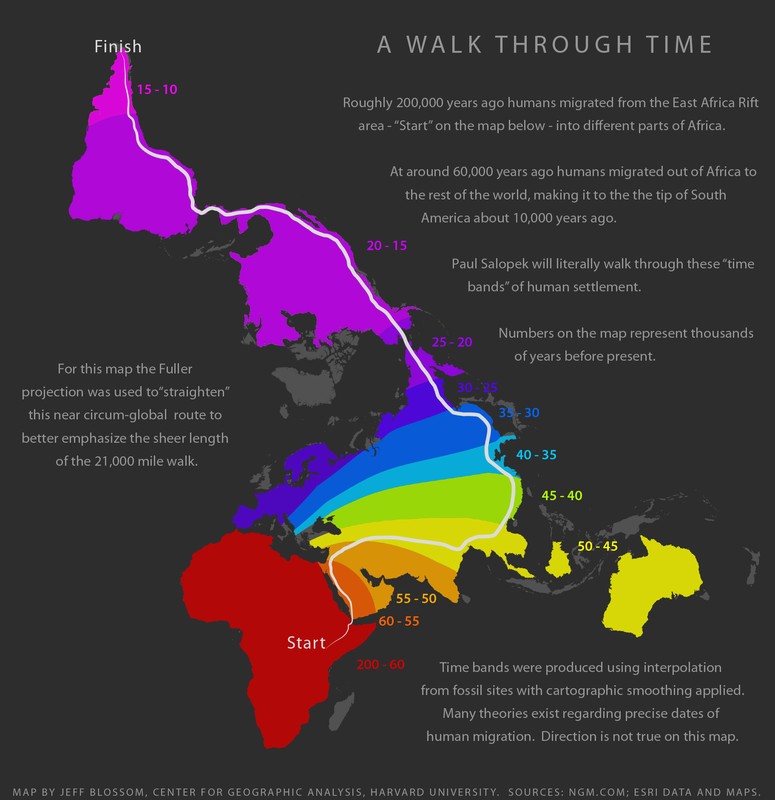
Paul began his journey in Ethiopia which I am a bit jealous of because I have always wanted to explore the culture and countryside there. Ethiopia is a land that is deeply embedded within their culture. On January 21, 2013 he set out on this amazing migration journey in Herto Bouri, Ethiopia along with his guide Alema Hessan.
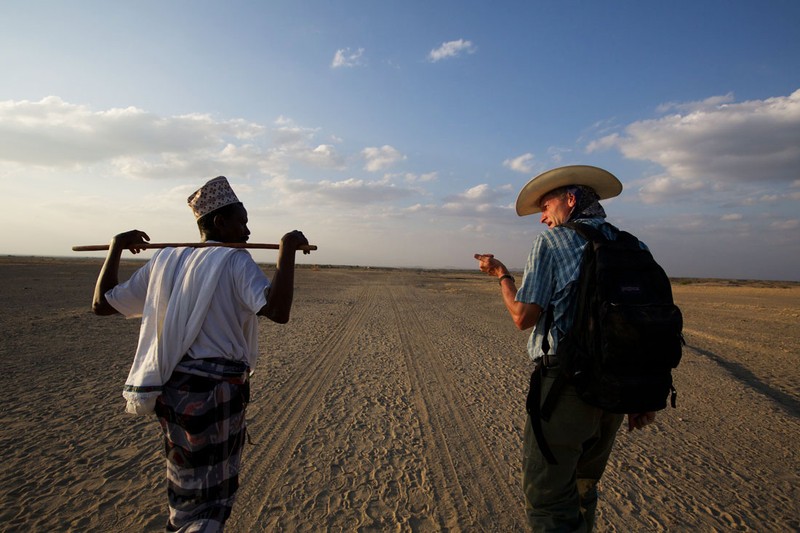
In the beginning of their trek, they lead a caravan of camels toward the Indian Ocean following their nomad voyages that walked before them. The aera that they are walking has some of the world’s oldest fossils from humans just below their feet. I would imagine it must be a humbling experience to walk the same route of so many. During their way through this vast countryside, they walk through the Rift Valley which is compared to a natural highway. With water being scarce they come across hand dug wells that provide a much-needed source for them.
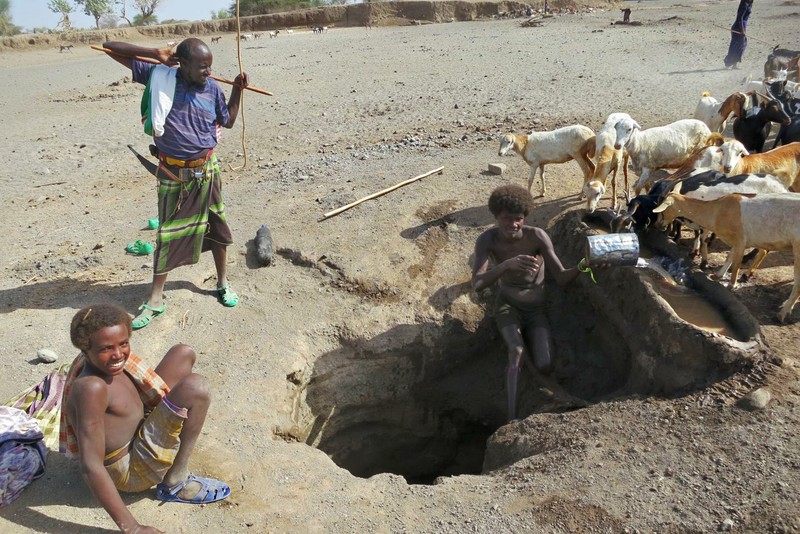
This is a humbling moment because sitting here in my comfortable house water is something I take for granted every day. The people that live and travel through this desert area rely heavily on the use of these hand dung wells.
The first aera I decided to explore Afar Badlands, Ethiopia
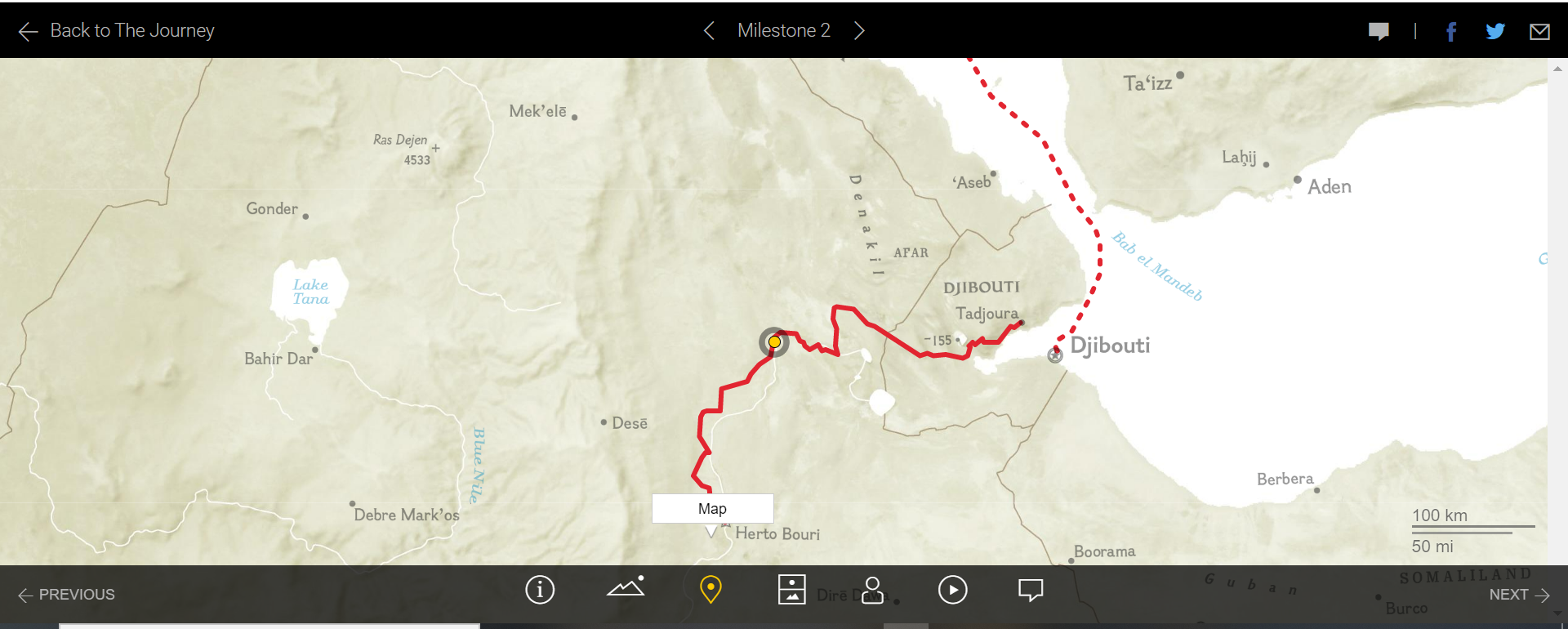
By day 19 they have reached a huge milestone of traveling 100 miles and enter into the Afar Badlands; I cannot imagine walking 100 miles. One very neat function of the tool is the Earth & Sky tool that allows you to view two images at the milestone destination. This would be exciting for students to get a real feel of what would be surrounding them if they were standing in that very spot. The contrast of the rough terrain below his feet and the rich blue sky above it magical.
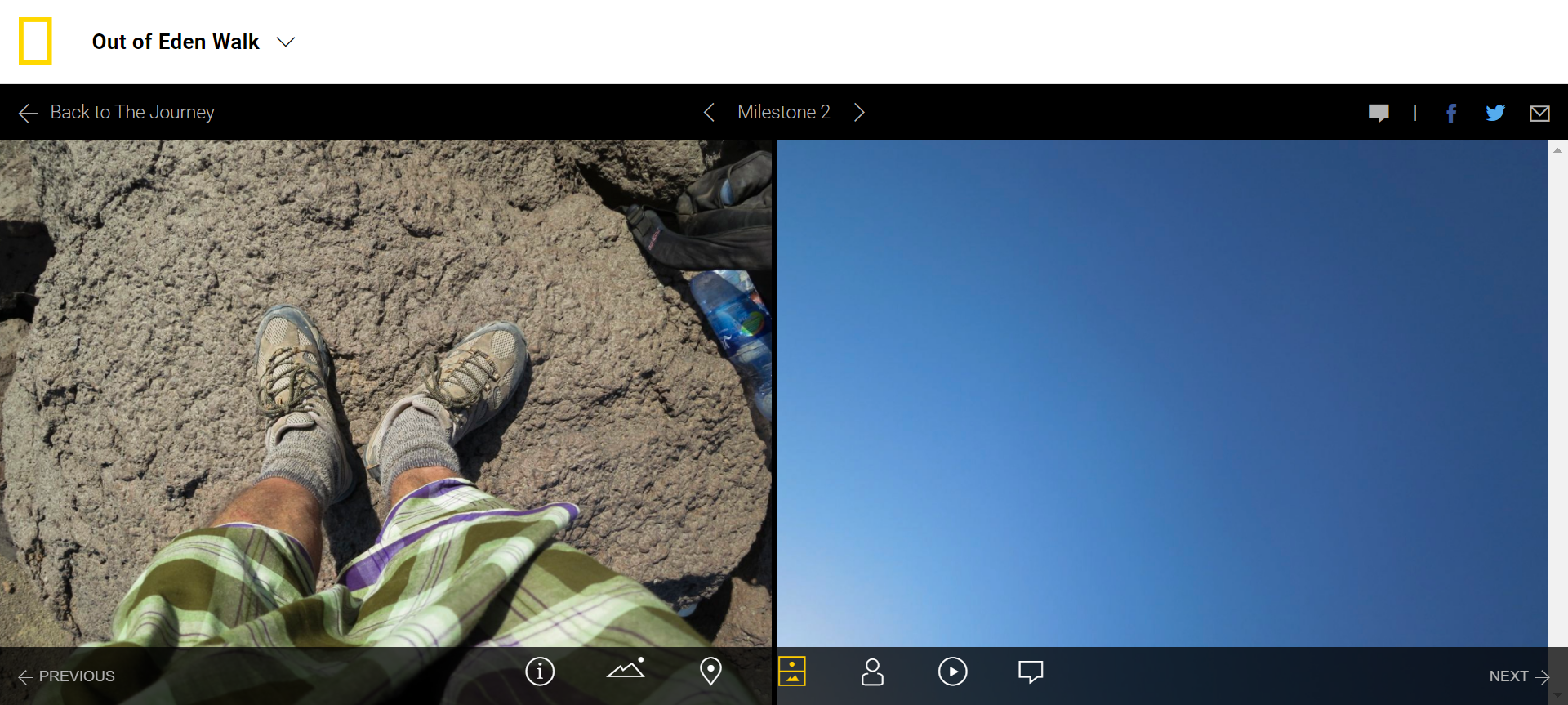
Another great feature of this tool is what they call glances that are videos that help you feel as though you are part of the journey. In this video we see the camels on their path right alongside a highway. For me this was also as the past meets the current society. The camels are a vital measure for this epic journey as they are carrying what the group needs for survival including food, water, and medical supplies.
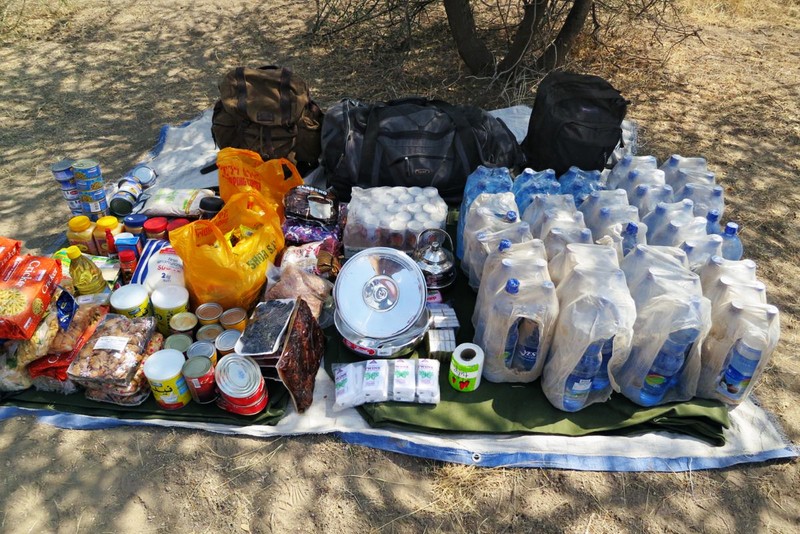
Seeing the means of travel via walking/ camel caravan is a good representation to make students apricate what great lengths the original people took. It is a great way to get students to think about life outside of what they know and help guide them to global citizenship. I think it could be helpful to challenge students to think about how people used to travel and how people live in regions that are far less industrialized. I think it could be helpful to open students minds and encourage them to empathize with those that have less available resources to them.
The second aera I selected to explore is Mile Stone 11: Near Dahaban, Saudi Arabia.

At this point the travelers have journeyed 1,000 miles and 136 days and it is now August. They have encountered many more obstructions such as farms, fenced aeras, factories, and subdivisions; obviously during the original route these did not exist. The desert sun has been unrelenting and I can’t even imagine how they were able to quest on under such conditions. The teacher in me thinks that this would be a great example to have students research the weather conditions in this region. In this milestone glances we see the camels and the group trying to take shelter from the heat of the desert under an over pass as travelers speed by on the adjacent highway. This just reemphasizes the harsh conditions of the region and the toll it is taking on those making this journey.
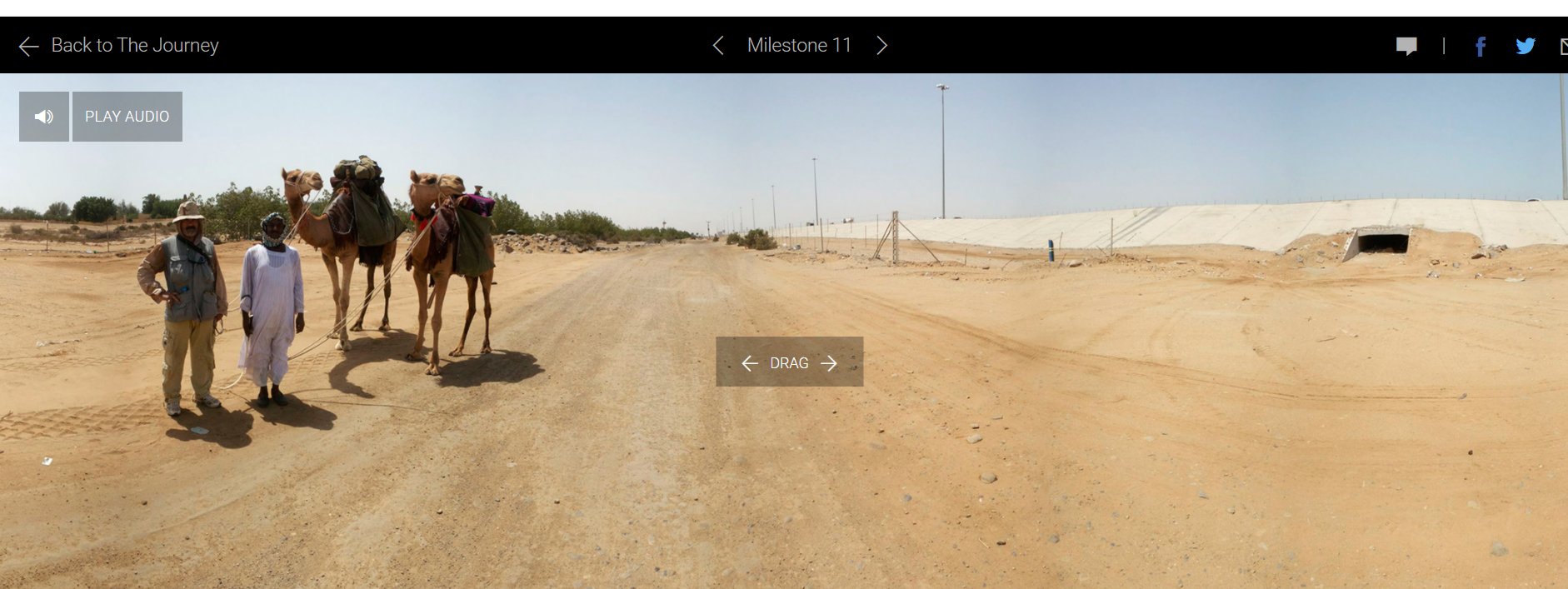
In this location there were no encounters as unsuspecting people sped by on the highway unaware of the monumental journey taking place just feet away from them.
Milestone 63 Near Varanasi, Uttar Pradesh, India
This is now day 2160 and they have traveled 6200 miles and are in a world far different than their beginnings. The glances section depicts a calm river with the sounds that surround them such as children. In the encounters we meet Phoolwanti Samayamu who is guiding her cows to drinking water.
Her story of the struggles that she endures living in the region under poverty touches me greatly. It seems as though the reduction in rain has greatly affected her lively hood causes much distress upon her family.
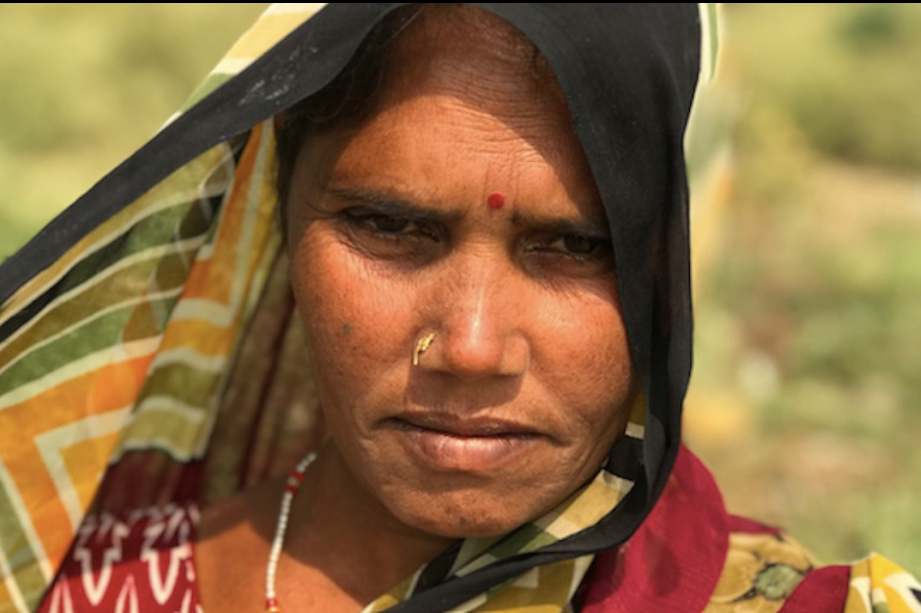
This would be a great to get students involved in exploring changing weather patterns and how global warming can greatly impact not only the landscape but people’s lives as well. The great droughts in India have impacted so many in everyday life and I think we need to encourage students to learn more about sustainable goals for their future. Water is often the key to sustaining life and is a vital point of many industries without water we would struggle.
Throughout the journey it is clear that Paul and the group has meet many different people across many different landscapes. I only explored a very small section of his great mission and can only begin to imagine what he has learned along the way. He has traveled through many different regions and cultures seeing many different struggles and successes. He has seen firsthand how society varies from location to location and explored populated regions that have modern technologies and remote villages that are barely surviving. I am thankful to experience this and can see how vital this could be in future lesson plans to challenge my students to think outside of New Jersey and their comforts.
Hyper Docs
Tiffany Imparato
A Hyper Doc is a virtual that empowers the student to have access to all the information needed for the lesson in one place. The digital format allows the student to have an organized lesson before them to explore and encourages critical thinking skills. By putting the learning in the “hands of the student, ” goodbye are the days of boring lectures and slide shows. There are various different ways Hyper Docs are comprised and personalized for example a group of google slides is known as a slide deck for students to explore. This is interactive deck replaces a teacher simply reading slides off to the classroom and engages students. There is also packaging of Hyper Docs that can include google docs, google maps, videos, and linked readings. A successful Hyper Doc always includes interactive features to engage students and have a measurable component. It could be as simple as responding to the doc itself or could include an outside feature such as Padlet or Flipgrid.
Why?
The whole class approach with Hyper Doc works great but rules need to be set to have students stay on task and appropriate. Advantages to this approach are confidence, collaboration, and easy accessibility. A teacher must have solid rules to combat any possible issues and teacher proper online etiquette.
The idea of having everything organized digitally for a lesson in one place is great for both teachers and students. It will excite students to have learning accountability and excite them to explore the Hyper Doc. It will also teach them the valuable lesson of staying organized and on task.
Virtual Field Trips
Tiffany Imparato
Virtual field trips are a fun and exciting way to bring your teaching beyond the walls of the classroom and promote technology based skills. Students of various ages can be emerged into another place just by the click of a button; this is extremely helpful due to so many restricts placed upon field trips and social distancing. Living close by in Southern New Jersey I embarrassed to admit that I have never had the chance to visit Ellis Island and explore the history there; so I have decided to attend a virtual field trip there.

On Scholastic’s website I was able to find a fun and interactive field trip of Ellis Island to explore without any traveling needed. With a few clicks of my mouse I was able to pretend that I was one of the 12 million immigrants that entered the United States through this piece of history. It is estimated that 40% of our nations population can trace their ancestors through Ellis Island. The virtual tours guides students through the various stops along the way as the life of an immigrant coming into America. The first stop was the passage of the overcrowded ships that immigrants had to endure next health officers would board the ship and prescreen passengers. The third stop was the baggage room where they were tagged before inspections. Next step was walking up the stairs to the registry under the careful eye of doctors looking for more signs of distress. This is where people reached the great hall for more observations before receiving their infamous 6 second physicals and moving to legal inspection. If an immigrant failed the health or legal inspection they were detained on Ellis Island for lengthy times. The 9th stop is known as the stairs of separation this is where one would go to medical detainment, legal detainment, or be free to enter the country. Those lucky enough might be greeted by awaiting family at what is now called the kissing post. It is sad to imagine how many dreams were made there and crushed as well.
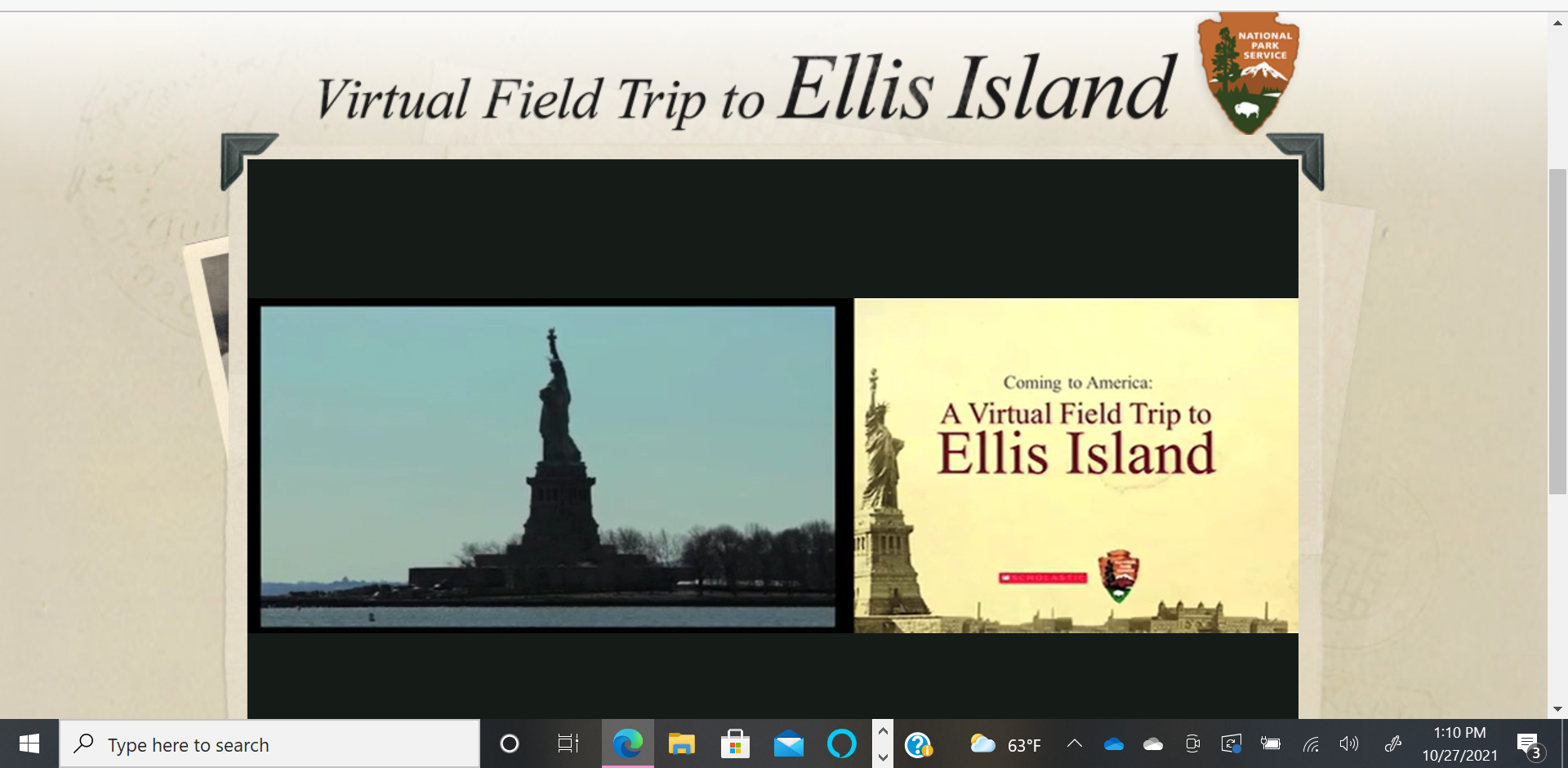
The virtual field trip includes many photos, audio links, and maps of the island in addition to the interactive tour. I can see this tour being used for various student age levels and could be followed up with fun learning assessments and projects. There is stories of young immigrants and great data as well to explore. I found this activity to be exciting and very informational and know that I will be using virtual field trips in my future classroom.
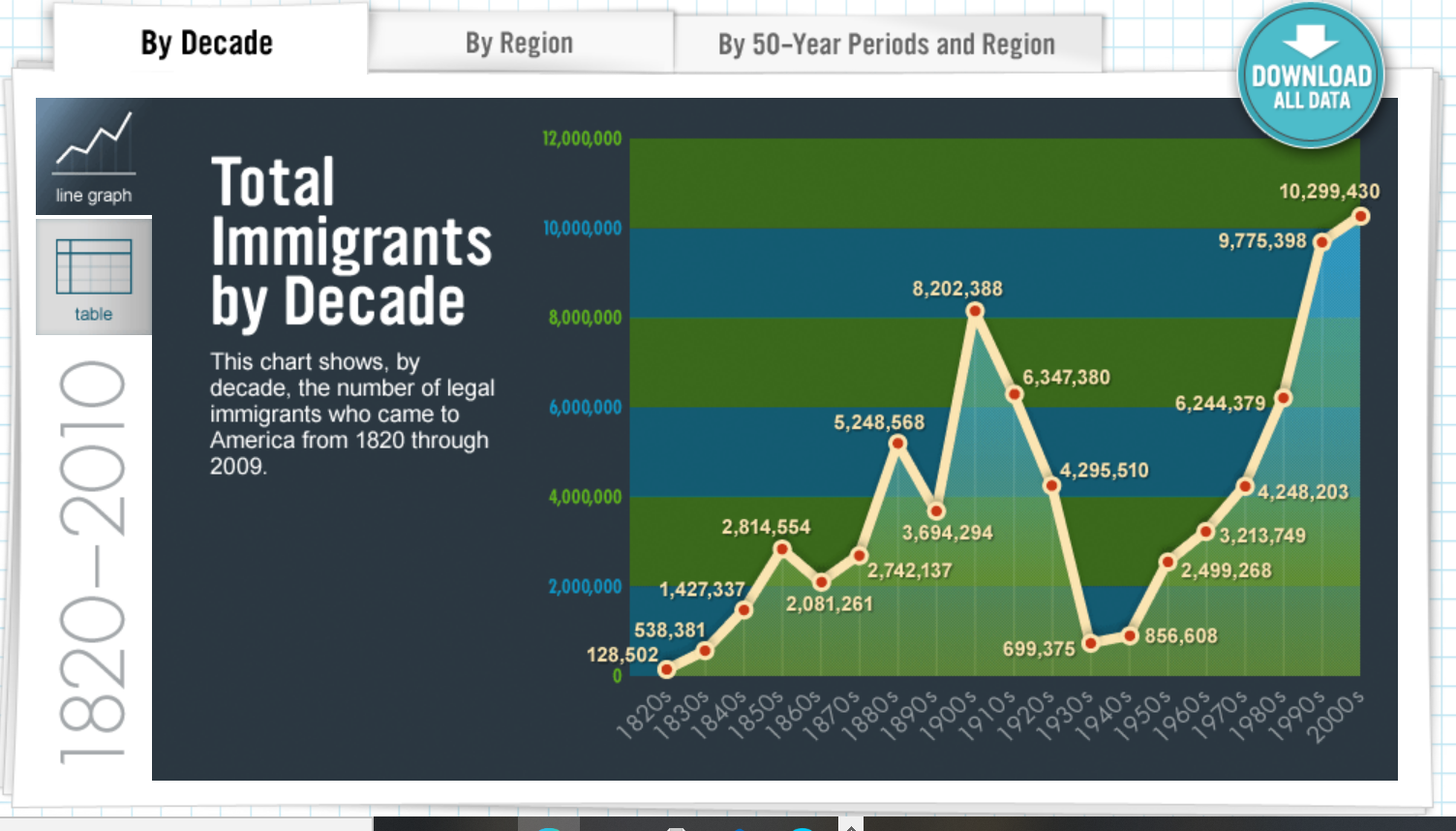
Subtitles
Be Yourself
By Tiffany Imparato

This week I was challenged to watch a movie or tv series from another culture in language other than English and utilize subtitles. I selected a Chinese series I found on u tube called 机智的上半场 or Be Yourself; which is a college aged drama following four very different young girls being their journey at school. First we are introduced to Xia on a her journey to school on a crowded subway through the city as she anxiously awaits arriving at the university. The city that she is traveling within is build up with massive sky scrapers and seems to have very modern architecture. Throughout her journey she is texting and taking many selfies which I think is universal for young women no matter what culture they are raised in. Xia appears to be a shy type of girl that is dressed very humble and may be considered a “tom boy,” by American standards. Next we meet Fan who is dressed very stylish and has people adoring over her she appears to be wealthy and privileged. One thing that I found odd is all the students appear to be checking into school alone in our culture often parents help children on move in day as it is an important event. When Fran arrives at her dorm she meets Yang who is a nerd type girl that is very inviting. The dormitory is cold and give a jail like feeling in my opinion they are not very homey. We finally meet the fourth roommate Huangfu who is a very shy girl that is very sad as she is missing her family. It should be exciting to see these three different girls cohabitate as they are obviously from various backgrounds. Some differences I noticed was the oddly small washer in the college laundry room, and the extremely modern buildings and structures throughout the episode. I also found it odd that they were required to pay for utilities in a dorm room on campus. The food that I saw in the episode was very different to me and I honestly was not able to make out what was on the plates. Some things I noticed that were similar was the weather and that the campus had nice grassy areas for the students to relax. Even though the girls are from an extremely different culture it was obvious that they enjoyed texting, nice things, and boys just like girls from many different cultures. There was however an unspoken hierarchy amongst the girls where Fran because she has money and nice things was treated a bit better I wonder if this is true of Chinese culture. Watching this show opened my eyes to many differences and similarities in just one episode and hope to continue to follow the journey of the girls and learn more.
Microsoft Presenter Coach
Tiffany Imparato
I recently learned about a tool that I would like to share as I believe that it can make a difference in any presenter or public speaker. Microsoft Presenter Coach, uses artificial intelligence based programming to turn anyone into a presenter through practice and detailed feedback. The best part is that anyone can try it free online and it is available across various platforms. I have had my share of nervous moments presenting in front of people after hours of practice yet still not feeling fully confident and I think that this tool can be a game changer. This tool is very versatile and can be used in the classroom very easily to empower both students and teachers to speak effectively and confidently. It is easy to navigate once a person creates their content they can chose rehearse with coach while practicing their presentation the speaker will receive onscreen help to guide them along. The coaching helps smooth the presentation by helping to avoid filler words, profanity, and keep a good pace. Once complete their is a detailed report to review that includes speed, fillers words, time taken, and suggestions on sensitive phrasing to avoid. Microsoft Presenter Coach is like having your very own public speaking coach always on hand. I think that this could be very helpful for students of various ages and wish I had this this when I was younger. I can definitely envision using this in my future classroom to help boost the confidence of my young learners to build skills that will last a lifetime.
Sustainable Development Goals
By Tiffany Imparato
For my blog post this week I have researched a sustainable development goal that is highlighted on the United Nations website that I have a personal connect with. In 2015 all the United Nation Member States adopted The 2030 Agenda for Sustainable Development and highlighted 17 extremely important goals to focus upon. Being a parent and future educator I decided to select goal #4 Quality Education.
This goal is to work towards “inclusive and equitable quality education and promote lifelong learning opportunities for all.” Sadly during the Covid 19 global pandemic according to the UN, 20 years worth of educational gains have been lost during this difficult time. Reading levels have reached historic lows as an impact and children are being negatively impacted without having access to quality education.
Some of the vital targets of this quest are access to early education programs and care to ensure proper development and support. I was lucky enough in my area to have access to such care for my children and understand the benefits however this is not the case in many areas. Target 4.3 calls for equal access regardless of sex to quality and affordable education such as technical schools and universities. Education must follow through to ensure an equal chance in adulthood regardless of sex or economical status. Todays students are tomorrows future and we must invest in that future! Goal 4.6 calls for increasing literacy which is so vital globally and a key instrument in success. Target 4.c calls for increasing the availability of quality teachers on a global level and to ensure all students are receiving the best chance in the classroom. The United States have pretty strict guidelines for teachers however often students in underprivileged nations are not having access to the best available candidates and this must be addressed.
The call for this goal will go much further than the 2030 plan and needs to remain a highlighted focus across nations. Education is vital to the success of society and ensuring that members are given the best chance of survival.
National Geographic Explorer Classroom
By Tiffany Imparato
This week I was challenged to research a learning tool that could be utilized within my future classroom. I decided to find a tool that can be fun and engaging since my target students will be K-6th; I chose National Geographic Explorer Classroom.
This is a fun interactive tool that is geared for student aged 4-14 years old. Classrooms can attend live events on varying subjects with special guests that help bring the classroom alive. Subjects include things like animals, the solar system, the ocean, and many other nature related topics. The events are ran by people who specialize within their given topic so that children can be delivered the best available information. Through video feed students can ask questions in real time with the specialist on camera or they can chat throughout the event through the chat option. The upbeat conversations appear to keep the students excited to learn from the explorer. I found a couple upcoming events that seemed interesting the first one focused upon the planetary system which reinforces science skills and STEM skills. This event was aimed towards children in grades 4-8. The next one that intrigued me was Tracking Elephant Seals which was lead by a marine biologist and gear for students in 4th -8th grade as well. This event appears to blend ocean life science and wildlife. I can imagine creating a whole module around one if these events having students research the topic, creating questions, and the writing summaries of their findings. I think that it is a fun way to introduce children to science and stem while working on research skills and writing skills as well. I can definitely envision utilizing this amazing service with my students. National Geographic’s goal is teach students how the world works so that they in return will treat the world better.

Collaboration In Education
by Tiffany Imparato

This week as a class we focused on the importance of collaboration and how it will be beneficial in creating our own PLNs. We are all aware of the high burnout rates for teachers and having a PLN to support and collaborate with is extremely valuable to both the educators and those they teach. Thankfully today we have many resources that allow teachers to collaborate virtually from anywhere. Teachers can use platforms such as Skype, Zoom, and Twitter to connect with fellow educators to support and share information to better their classrooms experience. The idea of collaboration can start as simple as connecting with fellow teachers in our your school environment to connecting with educators across the globe via blogs, social media, and many other resources. While searching Twitter I came across a valuable blog called Microsoft Education Blog that focuses on various concepts and support. Below I have shared a video of Heather Duncan-Whitt speaking about her own personal journey in teacher and how she learned the importance of seeking support outside the walls of her classroom.
Heather Duncan-Whitt





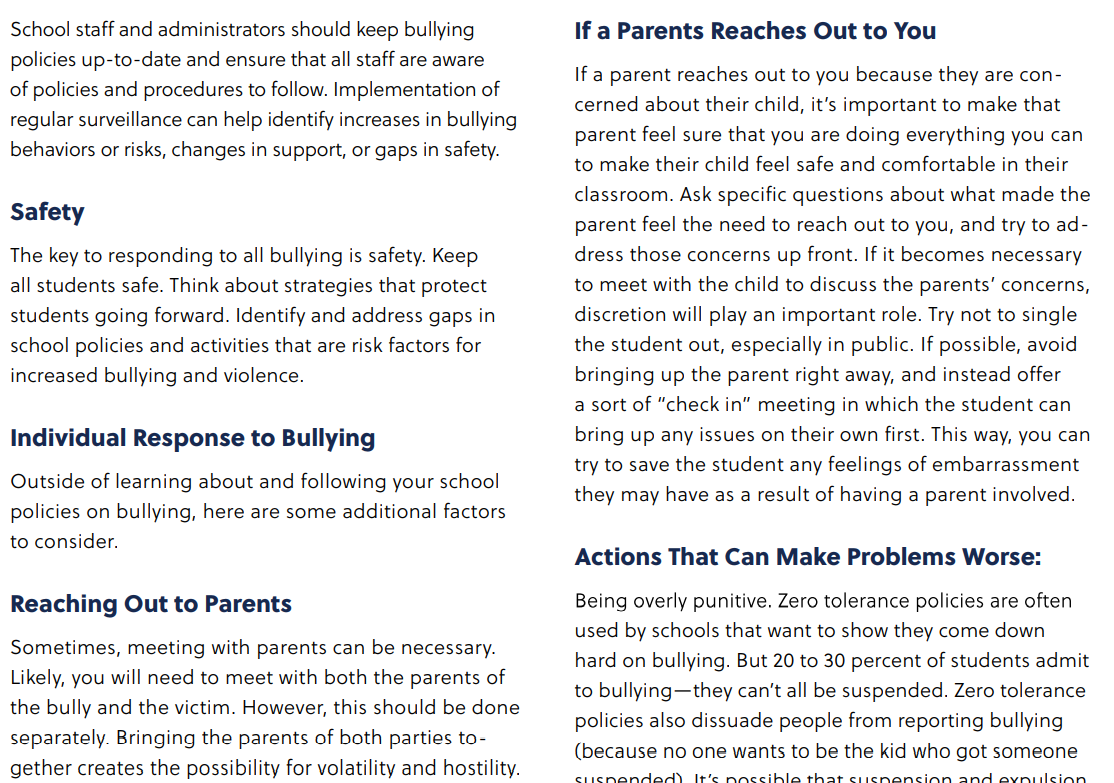

Recent Comments